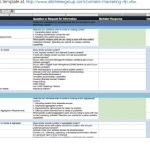
No matter which element of content marketing you think of, you have plenty of tools and solutions in the cloud to choose from. A number of suppliers provide web applications to assist management, production and distribution of content (e.g. its form, process optimizing and managing), measuring and analyzing its effectiveness. Here comes the challenge: how do you choose the tools you need? Rebecca Lieb of Altimeter Group forewarns against the numerous traps on the road to making a wise choice: for instance, the solutions we use may be duplicating some aspects, so in effect, we do the same thing twice. It all starts with articulating your needs and asking the right questions both to your providers and stakeholders. In its report Altimeter Group suggests how to create an RFP (Request for Proposal) for companies whose digital solutions you could use, so that you can get software best adjusted to your organization.
Altimeter Group has developed a form which is part of the software choice process for content marketing, and simplifies the whole task. The use of the form is based on seven steps:
1. Describe your goals and context
Content marketing continues to develop; this first step helps adjust organization to creating an RFP. Write a brief that contains the goals of the project, implementation summary, competitive solutions (if applicable), and the implementation time. A short brief helps suppliers understand your principles, goals and challenges.
When you include all that, add information to the “stakeholder feedback” tab in the form, where you’ll be keeping feedback from the key participants in the project (more in step 3.)
2. Determine the aspects of content marketing use, and decide which are your priority
The next step is to determine which aspects of content marketing use will be valid for your project. You need to think about which situations/aspects where content marketing is used will be useful in this particular case. The image below shows eight situations in which we determine marketing requirements. Each of them has many subcategories and is linked to other situations.
3. Gather the needs and demands of the entire organizations
Having a general idea about content needs of the organization, identify stakeholders and final users and seek their collaboration, by putting into circulation an RFP form with a feedback tag. Collecting feedback from people who will use it in one place makes it easier to follow.
It is important to treat the needs cross-functionally. Rebecca emphasizes that you need to gather information about needs from the whole organization, from the whole work cycle.
If you document detailed, individual needs, demands, problems and suggestions of each team, you will not miss anything. What’s more, this kind of cooperation creates a sense of ownership and supports the adaptation process of the final user of the program, especially in comparison to a situation when you impose certain tools on the teams.
4. Plan the integration and evolution of software
Thinking about integration is a necessity, because consolidation is driven by combined media and the development of complex content operative systems (e.g. Adobe, IBM, Google). Eventually, content marketing solutions are related to digital advertising applications.
Every aspect of content marketing use has potential integration possibilities with other uses. Identifying the key links will help you determine the final number of potential providers. Integration can be perceived in three ways: as integration with marketing systems, with the company’s system, or future integration. The last one requires much imagination and know-how – it is about determining how business and technological strategies that fulfill the goals of the organization will influence the integration needs, and about taking into account external forces, forming technological platforms, the changing functions and types of devices.
5. Develop inquiry context and supplier response form
Inquiry context provides a wider view of the company than that from the first step, and reveals the details of your strategy and your attitude to content marketing. This allows providers to assume an attitude to a wider perspective. If you outline the right questions around the strategy, needs and business goals, you get better response from providers. Such background also provides information about the company, the currently used tools and integration needs. The request should also include a decision making deadline, assessment criteria or budget information – anything you wish to share.
The supplier feedback tag includes particular requirements and questions, to help you choose the best providers (see step 6.)
6. Identify and line up providers
Having decided on the aspects of content marketing use and your integration needs, you need to determine which providers meet your requirements. Take a look at the priority aspects list formulated in step 4 and decide which providers have priorities similar to yours.
7. Arrange and compare answers
Holding all the responses in your hand, you can start comparing the available options. All feedback information can be included in the “consolidated supplier feedback” tag in the RFP form. Last but not least, go through the list of suppliers and inform the ones you haven’t chosen – you still might want to get into cooperation with them in the future.
 The subject of new form remains fresh, if your company uses different methods, if you would like to add or suggest something, write to Rebecca (@lieblink on Twitter)
The subject of new form remains fresh, if your company uses different methods, if you would like to add or suggest something, write to Rebecca (@lieblink on Twitter)
Kategorie: school of contentic